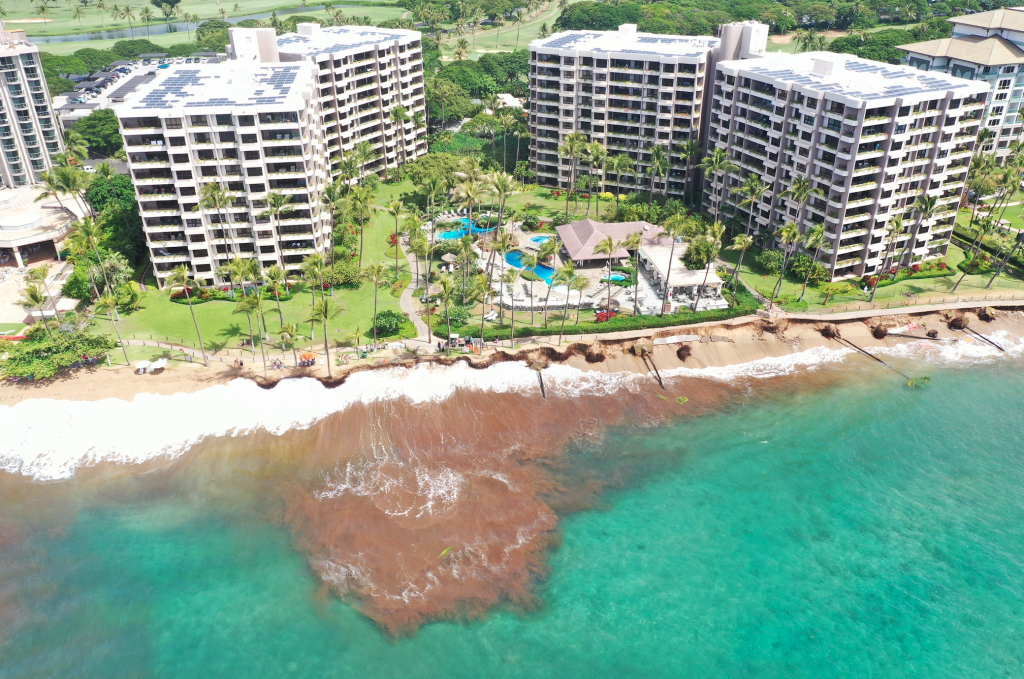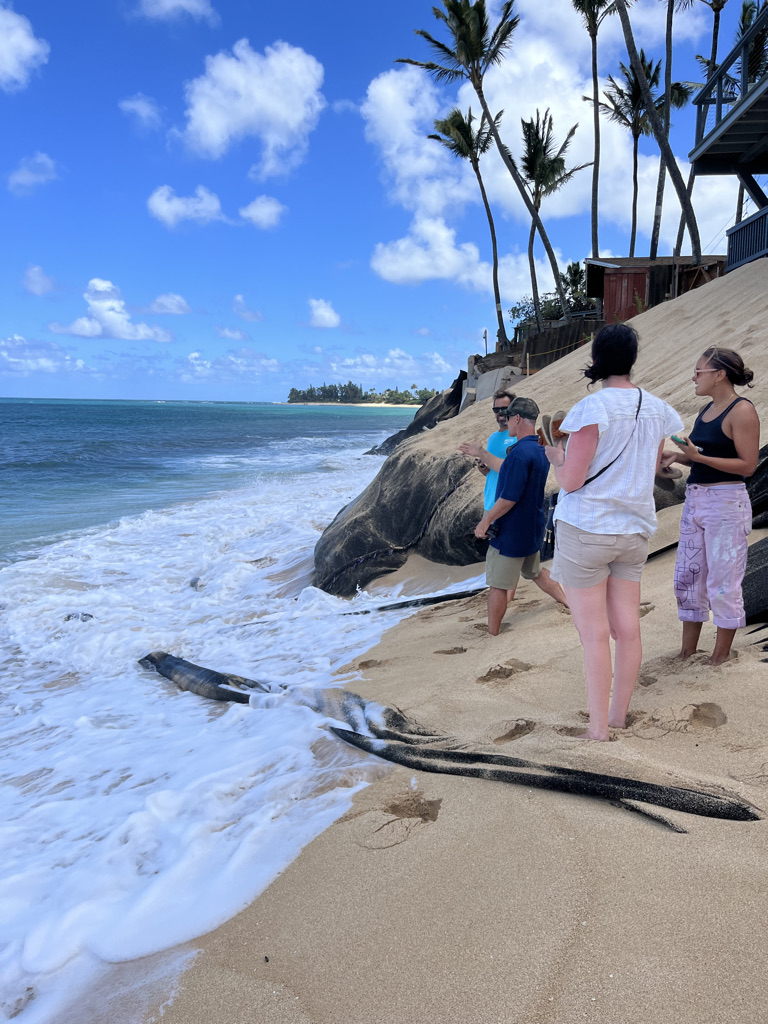
Already, 13 miles of sandy beaches have been lost throughout the islands and 70% of sandy beaches on O’ahu, Maui, and Kaua‘i are chronically eroding. On Maui, large swells recently sent a sidewalk in Kā‘anapali crumbling into the ocean. Sandbags dating back to 2003 were exposed, along with soil, falling palm trees, and PVC pipe. Tourists set up their beach chairs and towels along the collapsing coastline, as the sandy beach had effectively disappeared during high tide. Earlier in March, a private home collapsed onto the beach at Rocky Point on the North Shore of Oʻahu.

But it isn’t just structures that are lost when these events happen. The knee-jerk actions of hotels and homeowners to shore up their lots with illegal sandbags, sand burritos, and tarps result in the further loss of the natural beach.
The importance of healthy beaches and dunes for our communities in Hawai‘i cannot be overstated. They provide a natural buffer protecting coastal development and infrastructure from erosion and coastal flooding. Sandy beaches are also important cultural resources, serve as critical wildlife habitat, improve water quality, and provide immeasurable mental and physical health benefits to our community. Yet beaches are a fragile resource that exists in a delicate balance between ocean and landward forces. It should also be stressed that the beach is a public trust resource for the enjoyment and use of the entire community, a fact that is enshrined in the Hawaiʻi State Constitution.
Beaches migrate naturally and can fluctuate in width annually, seasonally, or even weekly (depending on the location). Sand dunes act as a sand “savings account” and allow the beach to naturally replenish itself. Building on top of these sand dunes, however, has robbed the beach of this ability. In many areas with significant coastal development, we are thus left with chronically eroding shorelines and dramatically smaller beaches that continue to shrink. The situation further poses a significant threat to public beach access and coastal users.
The chronic erosion of shorelines in Hawai‘i stands as a stark warning that we must immediately develop proactive management plans and a resiliency strategy for Hawaiʻi’s vulnerable coastal areas and properties. In many cases, this will likely require private and public property to move back from the shoreline. Other short-term, proactive steps include analyzing sediment budgets for erosion hotspots,, thoughtful beach replenishment or dune restorations to help buy time, and evaluating other adaptation measures, including raising homes and relocating vulnerable private and public property that is in harm’s way.

The dire situation of our sandy beaches on Maui, Oʻahu, and Kauaʻi should further spur action at the state level where critical legislation that will help facilitate coastal retreat is being heard by our state representatives. In 2022, the state legislature passed HB1672 that expands the counties’ ability to create special improvement districts and act as a potential funding mechanism for coastal property buyout. In 2023, Surfrider Foundation will be advocating for bills that limit temporary shoreline protection structures to 3.5 years and require homeowners to implement a long-term solution that will enable the removal of the structures.
But most importantly we need to pass comprehensive state legislation that supports managed retreat in an equitable and holistic manner. We must develop the funding, tools, and mechanisms that will allow vulnerable properties to adapt to, or retreat from, a shifting shoreline and, in the process, protect our public beaches for everyone’s use and enjoyment.
Help save Hawaiʻi Beaches:
- If you notice illegal activity on the shoreline (i.e. sand pushing, sand bags, tarps, jersey barriers, etc.) take a photo, post it to social media and use the hashtag #saveNS. Note the location of your photo.
- Call or message the Governor and demand that the state enforce fines and penalties for private property owners who undertake illegal and unpermitted actions on the public shoreline. The Governor has the authority to direct state agencies (i.e. the Office of Coastal and Conservation Lands and Department of Attorney General) to pursue enforcing these laws because it is leading to the destruction of public trust beaches and endangering the health, safety, and welfare of Hawaii's residents.
- If youʻre on Oʻahu, email Councilmembers Elefante and Kiaʻāina and request that they schedule hearings for Bill 41 and Bill 42 to update shoreline setbacks and ensure the city is conforming to the Coastal Zone Management Act.
- If youʻre on Maui, support the Countyʻs adoption of Shoreline Rules and Special Management Area amendments. The next public meeting is October 25 and public hearing is November 22. See the press release for details. Read the October 2022 updates to the proposed Special Management Area Rules, and Shoreline Rules amendments link to FAQs. Workshop presentation and more resources available hereHot Topics.
